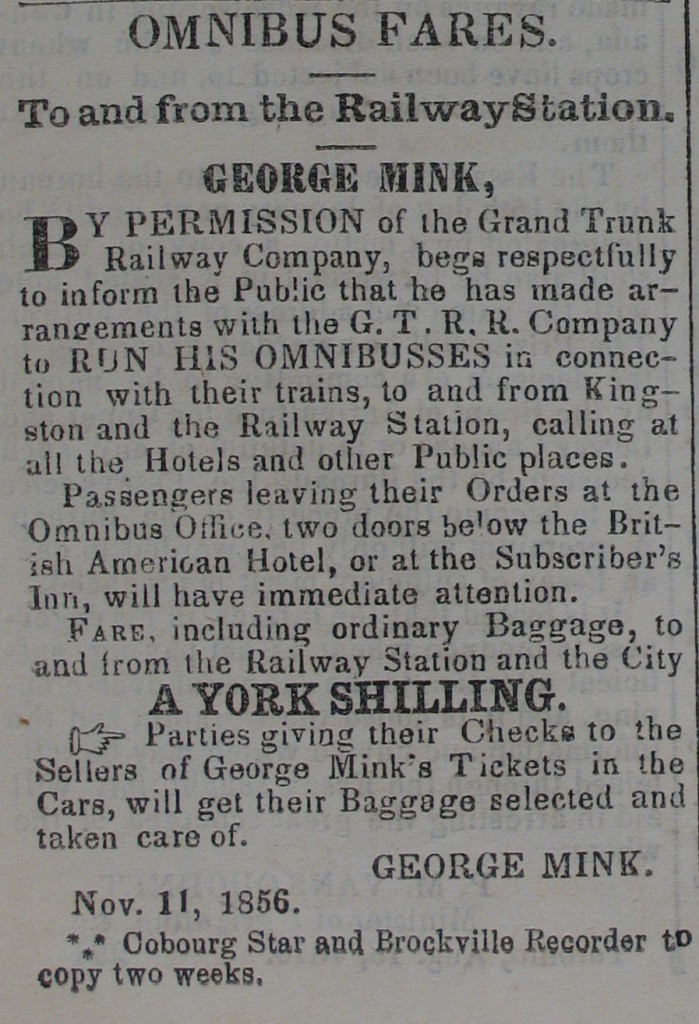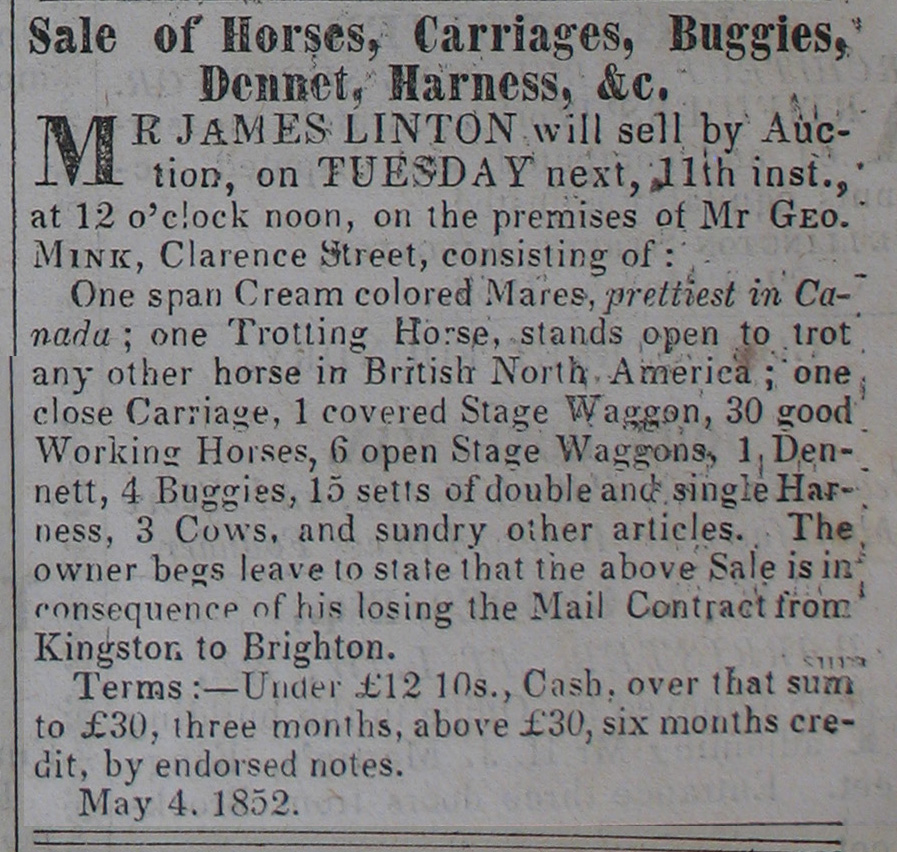Period : 1850-1900
In February 1848, George Mink let the public know that he had “removed his Tavern and Livery Stables to the new Stone House in Clarence Street, (sign of the Telegraph House,) Directly opposite his Old Stand…. “Stage Extras, Covered Carriages, Double Waggons, Light Buggies and Saddle Horses obtained at any hour of the day or night.” The location, according to land registry and assessment records, was lot 219, the middle lot on this block. Shortly thereafter, he won the contract for the mail route between Kingston and Brighton, running through Adolphustown and the Prince Edward District. Five two-horse carriages were assigned to the route.
While his business interests were progressing nicely, George experienced great tragedy in his personal life. His only son, George James, died in January 1847 at the age of four. Nancy Mink, his mother, passed away at Newburgh on 9 August 1849, followed two days later by his wife Ellen (with whom he also had three daughters) from the effects of cholera.
In December 1850, a signed requisition appeared in the British Whig, urging him to run as Alderman for Ontario Ward in the coming election. Commented the Whig, “the presence of a respectable, well-conducted man, like Mr. George Mink, though a man of color, would be a comparative credit to the coming board.” Some people thought it was done as a joke, and eventually he declined the opportunity, feeling that some of the signers were actually hostile towards him and were trying to further their own party purposes. If he had become Alderman, he would have been the first black man elected to public office in Canada West (now Ontario).
In September 1852, he married again. His bride was Mary Jane Adams of Toronto. At the end of the year, George won the contract for carrying the mail between Kingston and Cobourg. He was required to make seven trips per week, the route to be completed within 19 hours in summer. John A. Macdonald, who later became the first prime minister of Canada, was one of his sureties. Late in 1853, he picked up the contract for the Kingston-Montreal route. Extra business required more room; he rented property from Thomas Askew on Clarence Street to use as a stage office.
The coming of the railroad to Kingston in 1856 had a huge impact on George’s business interests. No longer would the mails be carried by stagecoach along the main east-west corridor. He made arrangements with the Grand Trunk Railroad to run his omnibuses, in connection with their trains, between Kingston and the Railroad Station. A price war, which developed between him and the cabmen, dragged on for two years and occasionally escalated into violence. His mail routes became smaller and paid less. An auction sale of horses, carriages, cutters, sleighs, etc. on 14 November 1863 signaled the move from his long-time residence on Clarence St. He briefly rented from Samuel Mucklestone on the northwest corner of Queen and Wellington, and then moved to Princess Street. We will learn more about George Mink at two later stops. (See Tour Items 9 and 11)
Additional information:
The Address 140 Clarence Street has been chosen as it plots as being located in about the centre of the post office block on Google maps.
“The location, according to land registry and assessment records, was lot 219, the middle lot on this block”
1. Notice that Mink will continue with the mail contract between Kingston and Cape Vincent, Feb. 3, 1845 3_February_1845 British Whig Standard
2. Notice/ ad of Mink’s tavern moving and news that he had obtained the mail contract, 23_February_1848 British Whig Standard
3. Notice of auction bc Mink lost mail contract between Brighton and Kingston, 4 May 1852, Daily News 8_May_1852
4. Notice of Mink’s arrangement with GTRR to run omnibuses “Omnibus Fares to and From the Railway Station” 15_Nov_1856, p.3 Daily News (Special Collections)
5. Signed requisition appearing in British-Whig in December 1850, Urging Mink to run as Alderman, British whig December 1850 (Special Collections)
6. Notice that Mink will run stage coach between Belville and Kingston “Travelling Accomodation; Kingston and Coburg” 21_Dec_1854 British Whig Standard (Special Colections)
7. Notice and ad for Mink’s stage coach between Belville and Kingston “War, War, War” 7_Feb_1854 British Whig Standard (Special Collections)
8. Notice that Mink will run stage coach between Belville and Kingston “An Accomodation Line of Four Horse Covered Stages” 27_Jan_1854 British Whig Standard (Special Collections)
A brief reference to George Mink is found in this online Genealogy record of 1851 at Kingston Canada Directory Professional Trades
The following data is extracted from The Canada Directory, containing the names of the professional and business men of every description, in the cities, towns, and principal villages of Canada. November 1851.
http://www.accessgenealogy.com/scripts/data/database.cgi?file=Data&report=SingleArticle&ArticleID=0032542
Telegraph House Stage Office
G. Mink, Clarence St., stages daily in winter at 8 o’clock in the morning to Bath, fare, 5s. Adolphus Town, fare, 7s. 6d.-Picton, fare, 10s. Wellington, fare, 12s. 6d. Brighton, fare, 18s, 9d. stage daily, except Sunday, to Cape Vincent, fare, 5s



